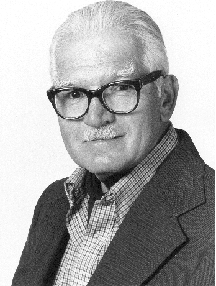 1912-2002
1912-2002
Wade Rollins was born in Jersey City, New Jersey. He was proud of his Native American heritage from his mother. His father was a career employee with the US Postal Service who moved the family to Los Angeles in 1926. Wade attended Belmont High School, doing well academically and in track and field sports. He went on to spend 2 years at Los Angeles City College before transferring to UC Berkeley where he earned an AB in mathematics in 1933 and an MA in mathematics in 1935.
After spending 2 years as a social worker in Alameda County, Wade volunteered in the International Brigade of the Loyalist Forces in the Spanish Civil War, serving as an artilleryman in the 14th Battery. When he left Spain he hiked over the Pyrenees in street shoes, carrying his belongings in a small wooden box that he kept the rest of his life. On his return to Berkeley in 1939 he was quite a celebrity with the Bay Area ‘left wing movement', giving lectures on the Lincoln Brigade of the Spanish Civil War. Wade went back to graduate school at UC Berkeley in 1939 in mathematical statistics and during this time also worked as a dance instructor, a reader, a social worker, and a claims agent for the US Employment Service. During the War he worked as an electrician in the US Navy shipyards in Vallejo.
In 1945 Wade was recommended as a person well qualified to analyze animal breeding data to Professor Paul Gregory in the Animal Husbandry Department at UC Davis. He resumed graduate studies completing his PhD in genetics in 1948. The following year he was appointed Instructor in Animal Husbandry at UC Davis.
Wade's career was one of productive research, excellent collaboration with colleagues, good teaching, and willing departmental service. He brought timely and valuable expertise in mathematical statistics to the department and became involved in projects with several livestock species, collaborating with physiologists, endocrinologists, nutritionists, and livestock managers to expand his knowledge of animal biology, husbandry, and non-genetic sources of variation in production traits. He analyzed the differences among cattle breeds and breed crosses in response to high temperature stresses at the Imperial Valley Desert Station, estimated the heterotic effects of crossbreeding in beef cattle, developed plans to use heterosis for the improvement of productivity, analyzed the effects of inbreeding, genetic variation, and inherited defects, and assembled a herd of muscular hypertrophic (double muscled) cattle on which he studied the biology of this syndrome and its potential applicability to improving beef production.
Dr. Rollins could be seen walking in town and on campus for many years after he retired in 1978, often at very early hours of the morning. In 1995 failing eyesight prompted his moving to San Diego to be near his son.
